As a foodie and a world traveler, I’ve always been intrigued by the world of Japanese street food. It’s a world that’s as varied and complex as any other cuisine on the planet, and the fact that it’s made with mostly fresh, delicious ingredients sent me on a journey to find the top places to eat Japanese street food in Tokyo from the moment I landed at Narita Airport.

During that journey, I fell in love with the beautiful, complex, and diverse flavors and textures, which made my taste buds sing and my waistband expand. It was all more than worth it, and helped make my twelve days in Japan an experience I will never forget. These are the top 3 places to eat Japanese street food in Tokyo!
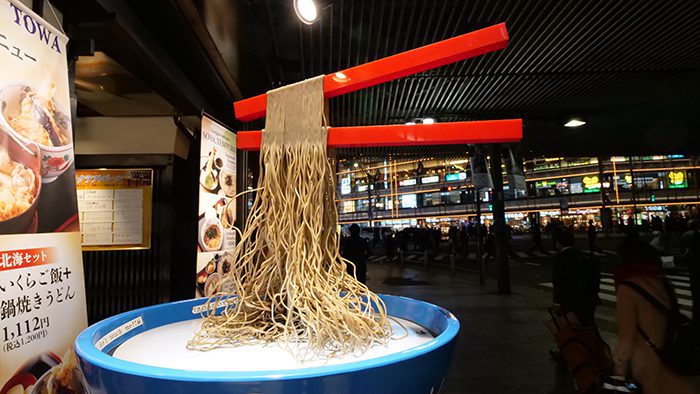
There are many places in Japan where you can buy incredible street food, but none has gained the fame and acclaim of travelers and foodies from around the world quite like Ameya-Yokochō Market.

This 164,227 square-foot open air market, often shortened to Ameyoko Market, served as a popular place to buy candies and sweets post-World War II and was also the site of a black market that sold surplus U.S. Army goods in post-war Japan.
Check out 15 Places to Eat Japanese Food in Tokyo, Japan

In the years since then, the market has transformed into street market is home to over 180 shops. While the market is known worldwide as one of the best places to eat Japanese street food in Tokyo, you can also find vendors selling clothing, accessories, fresh fish, and souvenirs. And while Japanese food is the most prevalent here, you can also find delicious treats from China and South Korea!

One of my favorite foods I tried during my 12-day trip to Japan is takoyaki, which are round balls of dough that contain chunks of octopus. When I visited Ameyoko Market with my friend Shinichi, the shop selling them was already sold out, but if they’re available when you go, do not hesitate to try them! They’re tender, chewy, and practically fall apart as you pick them up, and the octopus in them is succulent and delicious.

If you’re in the mood for some inexpensive and high-quality fish, you have to try the seafood half-bowls (300 Yen/roughly $2.80 U.S.), which you’ll find near the takoyaki stand. The bowl I bought came with squid, tuna, salmon, salmon roe, minced tuna, and some sushi rice with soy sauce and wasabi on the side.
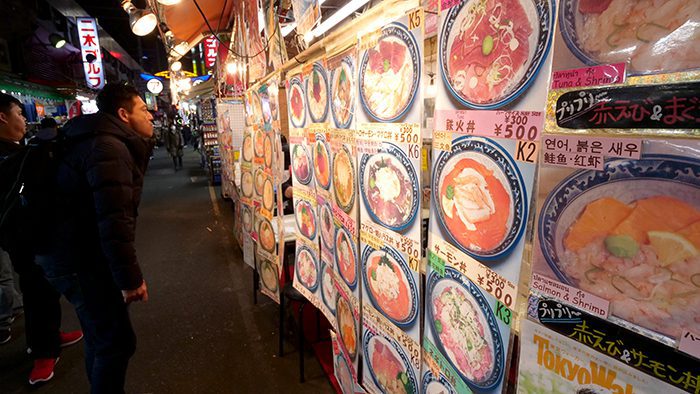
The salmon was so fresh and buttery, it tasted like it had just been swimming moments earlier! I also loved the briny flavor of the salmon roe. Roe is sometimes called the gems of the sea and after trying these incredible salmon eggs, I know why!
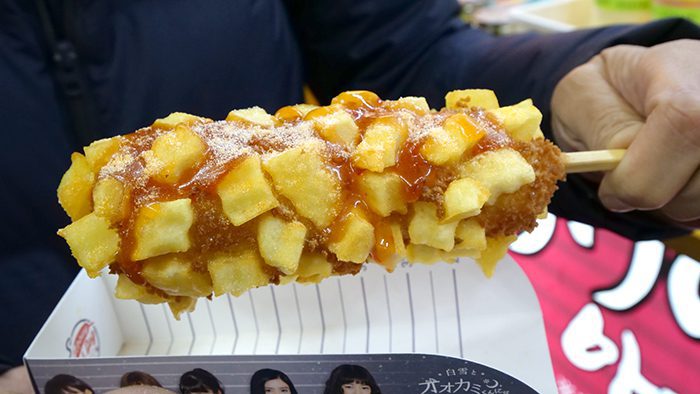
The squid was nice and chewy and the minced tuna was so fantastic, it blew my mind! Keep in mind, if you’re not a huge fan of spice, you might not want to use much of the wasabi. It’ll set your tongue ablaze if you’re not careful with it!

If you’re like me and like to only eat local fare when you’re visiting a foreign country, you might be inclined to skip Arirang Hot Dogs, but before you continue past it, make a quick stop to try the Potatorella (480 Yen/roughly $4.30), a trendy dish on a stick that consists of a crispy, fried potato exterior that is stuffed with lots of hot, gooey mozzarella.

Try it with the sweet chili sauce and garlic! It’s unusual and pretty heavy, the combinations of crispy/creamy and sweet/spicy are phenomenal and make it a must-try!
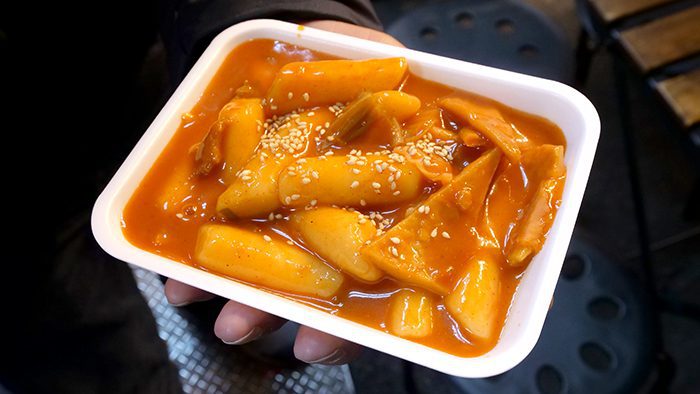
The next street food you must try at Ameyoko Market is a popular Korean dish called tteok-bokki, which consists of mochis, or glutinous rice cakes, in a sweet and spicy gochujang sauce with fish cakes, sausage, and green onion.

While mine didn’t contain sausage, the dish was still fantastic. I loved the gooey texture of the mochis and the gochujang sauce was like a cross between sriracha and sweet-and-sour sauce. And while it was certainly spicy, I was told that the Korean version is downright fiery!

Japan is home to some of the freshest and most delicious raw seafood on the planet, so when in Rome, do as the Romans do, right? As you continue exploring Ameyoko Market, you’ll come across a shop selling some pretty massive oysters. I recommend having them with a squeeze of lemon and some ponzu sauce. At just 1,000 Yen, or around $9 U.S. for five huge oysters, they’re more than worth the price!

At that same shop, you’ll also find shishamo, which is a type of smelt. These small, saltwater fish are served whole. They’re given to you nice and hot, and have a pretty mild flavor. While they’re not overly salty or fishy, I was pleasantly surprised that they had roe inside of them, which was a delightful flavor explosion in my mouth. The shishamo does contain bones, but they’re so delicate, they can be chewed and swallowed with no problem. I recommend trying them with some Japanese mayo for an outstanding flavor combination!

The final thing you must try during your exploration of Ameyoko Market is some sake! There is a stand-up bar in the market that offers twenty different varieties of the Japanese rice wine. Just remember that even though sake may be very light, that doesn’t mean it also isn’t strong, so pace yourself!

There is so much more that Ameyoko Market has to offer, so explore at your own leisure. With so many options, it’s easy to see why Ameyoko Market is one of the top places to eat Japanese street food in Tokyo, so the next time you’re in the city, do yourself a favor and check it out!

Asakusa is a historic area of Tokyo’s shitamachi, or low city, that served as the city’s most popular entertainment district during the Edo period. During that time, Asakusa contained kabuki theatres, movie theatres, and a red light district.
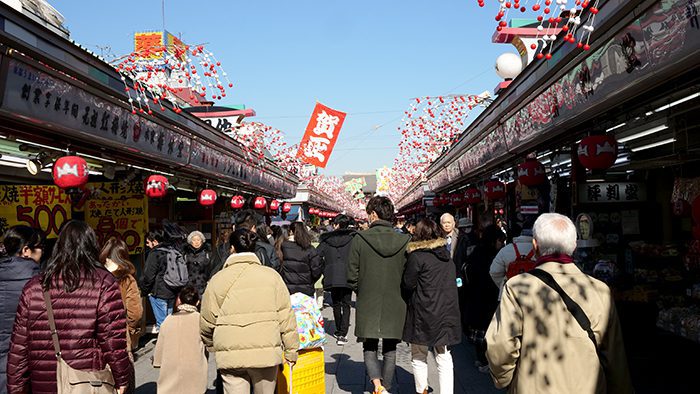
But after the air raids of World War II destroyed much of Asakusa (including its main attraction, Sensoji Temple), the entertainment options were never rebuilt and the area became better known for its temples, shrines, shopping, and street food.
Check out 5 Places You Must Eat at in Kyoto, Japan

Asakusa’s Nakamise Dori street is a fantastic place to try a variety of Japanese sweets. One of my favorites there is kibi dango, a traditional Japanese snack that consists of mochi balls covered in millet flour on a stick.
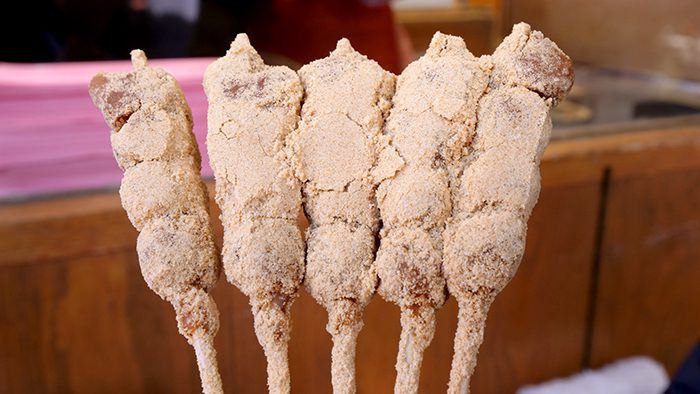
The mochis had the signature, gooey texture I love so much, and the millet flour had a nutty flavor that reminded me of peanut butter. I couldn’t get enough of it!
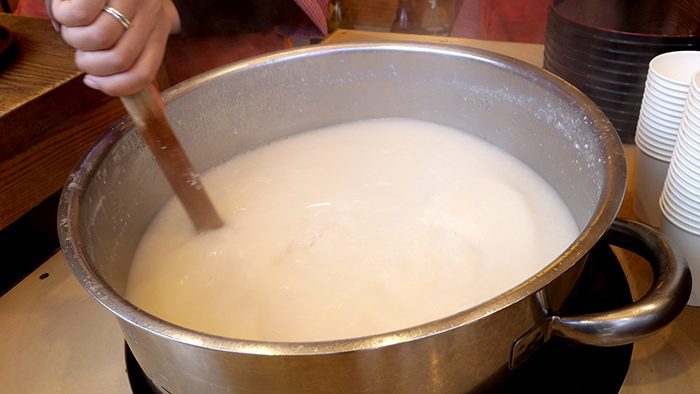
If you have the pleasure of visiting Japan in the winter like I did, your excursion down Nakamise Dori will probably be a chilly one. Luckily, there is a sensational, warming drink called amazake that is only available during the winter months. It’s a hot, fermented rice drink that is kind of thick and slimy, but it’s also super flavorful and will warm you up quickly!
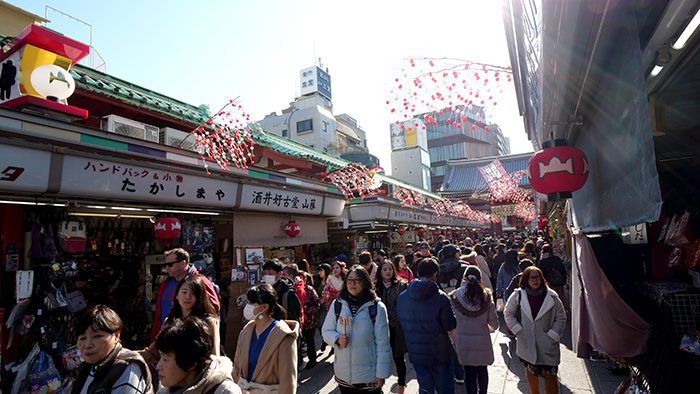
While exploring Asakusa’s Nakamise Dori one street food you absolutely have to try is the ichigo daifuku. These are large mochis that have an assortment of fillings. I tried two of them and had my mind blown by them both!
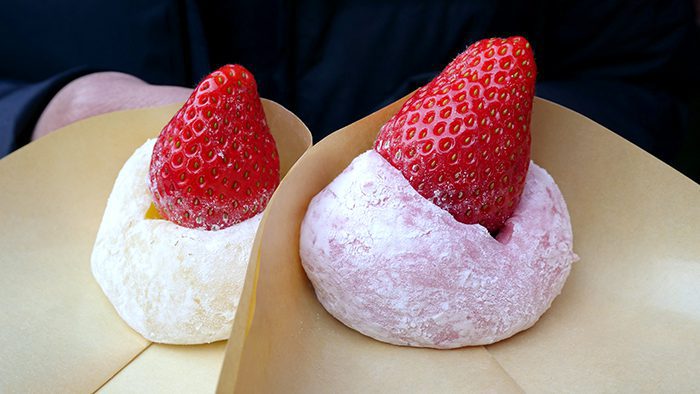
The first of the two was an ichigo daifuku that contained red bean paste and a huge, juicy strawberry. In Japan, strawberry season is in the winter, so you can find lots of interesting varieties of the fruit during the colder months, and this strawberry in particular was so fresh and flavorful.

The strawberry, combined with the glutinous mochi and delicious red bean paste, had me in Japanese sweet heaven!

The second ichigo daifuku contained a thick, creamy custard. I didn’t love it at first, but it grew on me as I continued eating. By the time I finished it, I couldn’t stop raving about how amazing it was!

In Japan, sweets containing red bean paste are very popular, and another Asakusa street food that uses it is ningyoyaki. These are small, stuffed pancakes that are made, via molds, in the shapes of objects like pagodas and birds.

The pancake part is nice and savory, while the red bean paste inside is gooey and sweet. It’s a wonderful combination you have to try! You can get six for 550 Yen, or roughly $5 U.S.

Menchi katsu is a savory and meaty option you can buy along Nakamise Dori. It’s a moist and juicy deep-fried patty made of beef, pork, and onion. It has a flaky crust on the outside that gives it a nice texture, and the different meats and onion give it a fantastic mix of flavors. It’s another must-try!

Another savory option you should try is the monja, which is a deep-fried fritter. I tried two kinds: the original and the curry flavor. Both were hot and moist with lots of tasty herbs, but the curry one had a delightful curry on the outside that had my taste buds going wild!
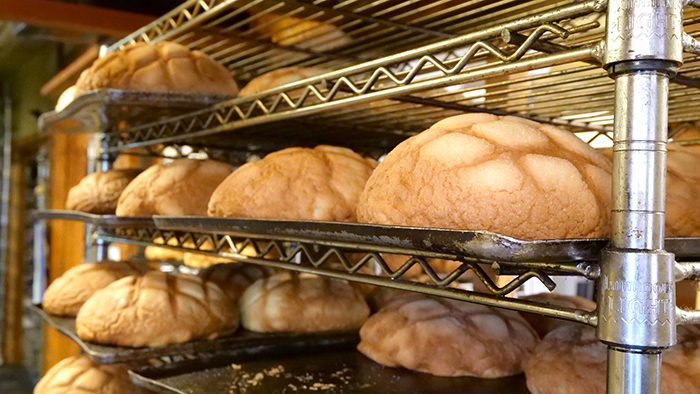
With a few savory foods now in your belly, it’s time for dessert! There’s no better dessert option in Asakusa than a melon pan, which is a Japanese sweet bread whose crust looks similar to the outside of a melon.
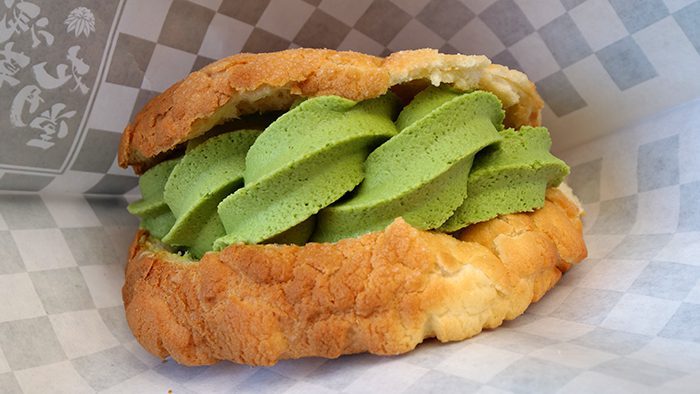
If you want, you can get yours stuffed with a mind-blowing matcha ice cream. The combination of the warm, fluffy bread and cold, creamy ice cream is heavenly and a perfect way to end your day at yet another of the top places to eat Japanese street food in Tokyo!
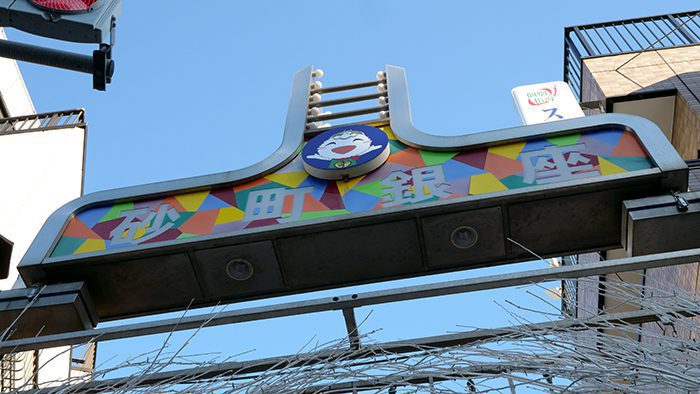
Sunamachi Ginza is a 670-meter-long shopping district that is chock-full of different types of street food. Many of the businesses here are family-run. This shopping street is often skipped by tourists, and because of that, it is a the perfect place to go to experience a slice of local Japanese life.
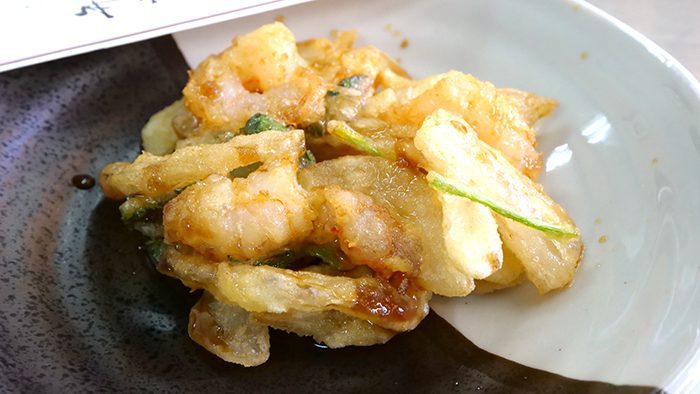
The food at Sunamachi Ginza is out of this world and makes it a foodie paradise you have to visit if you want to properly explore the best places to eat Japanese street food in Tokyo!
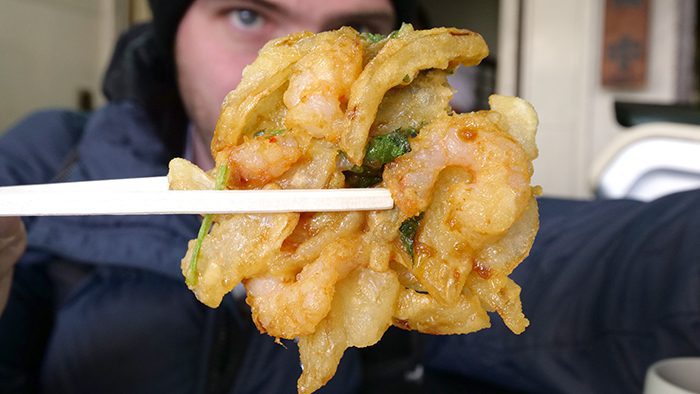
One of the best tempuras I’ve ever had was the fried tempura fritter containing shrimp, onion, and other vegetables that I bought at Sunamachi Ginza. The crunchy tempura batter along with the succulent shrimp and flavorful vegetables makes it a winning dish you have to experience for yourself!
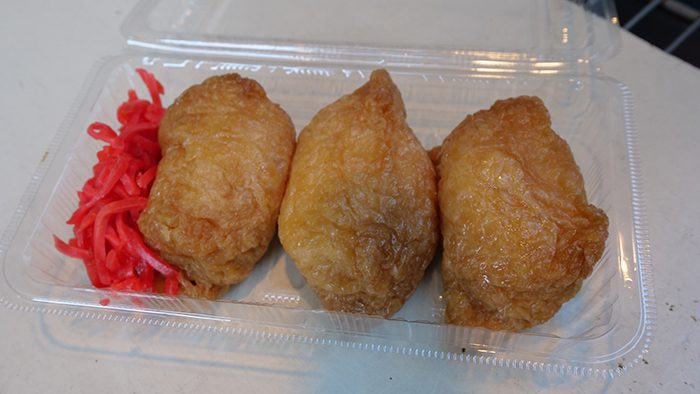
Keep exploring and you’ll find an amazing shop that sells a phenomenal dish called inarizushi, a deep-fried tofu pocket that contains a ball of sushi rice and soy sauce.
Check out Top Places to See and Eat at in Osaka, Japan

The outside of the tofu has a sweet sauce that tastes almost like honey. They’re filling, so I suggest sharing them with a friend if you’re planning on trying more foods! You get three inarizushi for 150 Yen, or roughly $1.35 U.S.

There is a great shop at Sunamachi Ginza that sells a variety of miso paste. It’s a popular ingredient in Japanese cuisine, and the shop actually lets you sample different ones with a toothpick. They have one that ferments for three years and has such a rich and potent miso flavor, it blew my mind!

I recommend you try the deep-fried minced tuna cutlet, which is crunchy on the outside and very soft on the inside and delivers a nice pop of onion flavor. You can also drizzle a sauce over the cutlet, which makes it a little sweet!

You can’t visit Sunamachi Ginza without having the traditional Japanese food called oden, which is a hot pot dish that contains lots of different items including a spicy cod fish cake and daikon radish. This popular winter dish tastes a lot like miso soup.

I loved the moistness of the cod fish cake and the addition of carrots and onion. The daikon was soft and flavorful because it had absorbed so much of the miso broth. It was fantastic!

Next up is a very popular Japanese dish called yakitori, which is grilled and skewered meat. There’s a shop that sells seven different types, but I only tried two: the pork neck and the original yakitori, chicken with spring onion.

I’d never had pork neck before, but I loved it! The charcoal it was cooked over gave it a rich, smoky flavor and it was still very juicy. I also loved the moist meat of the chicken and the crunch of the spring onion.

A great dessert option at Sunamachi Ginza is the taiyaki, which is a fish-shaped cake that’s stuffed with red bean paste. The outside is hot and super crunchy and tastes like a fresh waffle. It was so hot that it warmed me up on this cold afternoon in Tokyo!

And finally, close out your meal by enjoying a drink surrounded by locals! I had a sweet and super dry sake that was absolutely incredible, and at the very end of my tour, I was given the opportunity to brew some high-quality green tea that was different from any green tea I’d ever had. I loved the flavor of it!

If immersing yourself in the food scene and culture of the places you travel to is something you enjoy doing, you have to visit Sunamachi Ginza.

The fantastic food and amazing locals make it one of the top places to eat Japanese street food in Tokyo, and I guarantee you’ll have an unforgettable time there!

Though this list of places to eat Japanese street food in Tokyo is short, the list of incredible and diverse foods you can find there is anything but. Each of these street food markets is large and busy enough to spend hours exploring, and if you’re a foodie like me, you won’t regret it.
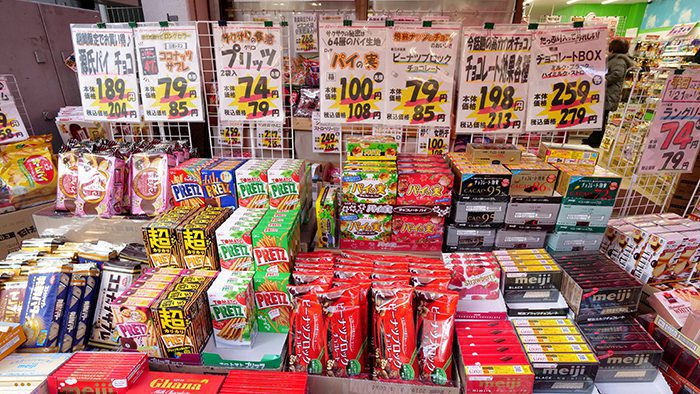
Book your trip to Tokyo now to begin your Japanese street food journey!

NOTE: When you travel, you should buy travel insurance to protect yourself in case of an emergency. AXA Travel Insurance is the very best because it covers a wide array of issues. I use it on all my trips and swear by it. Buy your AXA Travel Insurance protection plan here!
Counter
101 Countries • 1432 Cities